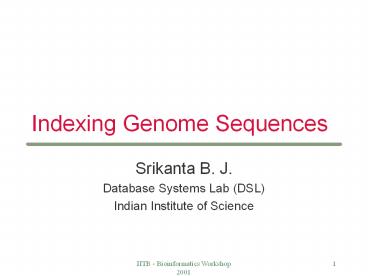Indexing Genome Sequences - PowerPoint PPT Presentation
Title:
Indexing Genome Sequences
Description:
State of the art. Dynamic Programming. Slow but accurate. Never ... Not suited for average DNA/Protein query lengths. IITB - Bioinformatics Workshop 2001 ... – PowerPoint PPT presentation
Number of Views:61
Avg rating:3.0/5.0
Title: Indexing Genome Sequences
1
Indexing Genome Sequences
- Srikanta B. J.
- Database Systems Lab (DSL)
- Indian Institute of Science
2
Background
- Sequences
- DNA (Deoxyribose Nucleic Acid)
- Proteins
- Similarity of sequences
- The extent to which nucleotide or protein
sequences are related - Percent sequence identity, and/or Conservation
3
Genome Sequence Analysis
- Hypothesize
- Function of Proteins
- Phylogenetic trees
- Causes of Diseases
- First step in unraveling the mystery of Life!
- Sequence Similarity ? Structural Similarity ?
Functional Similarity
4
Sequence Similarity
- Alignment
- between two sequences, S1 S2 (perhaps of
unequal length) - Insert spaces, into or at the ends of S1(S2)
- Place them so that every character or space in
either string is opposite a unique
character/space in the other.E.g.,q a c - d b
dq a w x - b - - Global Local Alignments
5
Alignment
- Global
- Given two sequences, find best alignment over
full length - E.g., between (agtcacaaaact, actcgga) a g t c a
c a a a a c t a c t c g
g a - - - - - - Local
- Look for islands of high similarity
- E.g., between (agtcacaaaact, actcgga) a g t c a
c a a a a c t
a c t c g g a
O(mn) with Dynamic Programming
6
Scoring the Alignments
- Scoring Schemes
- Value for aligning character x against character
y - Provided as scoring matrix, for alphabet ?
- E.g.,
- BLOSUM
- PAM - 120
- DNA-BLAST (5 for match, -4 for mismatch)
- Optimizing alignments
- E.g., Edit Distance
- Scoring Scheme Insert - 1, Delete - 1, 0
otherwise - gt edit_distance (surgery, surgeon) 4
7
Search Process
- Given sequence to be studied
- Want all similar (global/local) known sequences
- Collections of sequences
- NCBI-GenBank, SwissProt etc.
- Contain millions of sequences
8
State of the art
- Dynamic Programming
- Slow but accurate
- Never misses a significant alignment
- FastA
- Faster than Dynamic Programming
- Uses statistical heuristics
- Reduced sensitivity ? False dismissals
- BLAST
- Fastest and popular
- Lower sensitivity than FastA
- Requires whole database in memory!
9
BLAST - on 1,000 Budget!
- BODHI experience DSL, 2001
- 51,000 DNA sequences in database
- CAFÉ Experience Williams and Zobel, 2001
- 120,000 DNA sequences in memory
- Time - 67.1 seconds/BLAST
? 10.6 seconds / BLAST
10
NCBI GenBank Growth
- Doubles every 13 months
- In 1998, estimated 40,000 sequence similarity
queries per day - That was 3 years ago!!
11
We Need Indexes for Sequence Similarity
Searching NOW!!
12
Indexed Searching
- Inverted Indexes
- RAMdb Fondrat and Dessen, 1995
- CAFÉ Williams and Zobel, 2001
- FLASH Califano and Rigoutsos, 1993
- Multi-Dimensional Indexes
- MRS-indexing Kahveci and Singh, 2001
- Persistent Prefix Tree Hunt et al., 2001
13
RAMdb (Rapid Access Motif db)
- Each sequence in repository is indexed by
constituent overlapping sequences - 800-fold speedup over Dynamic Programming
- Prohibitive index size
- No ranking (goodness) of alignments
- False dismissals
ACTC
Seq1, seq2,
Seq1, seq4,
CTCG
14
CAFÉ
- Partitioned Search
- Coarse searching with compressed inverted index
- Fine searching in small fraction of database,
with ranking - 14-fold speedup over BLAST
- Compression reduces the index size
- Distant sequence relationships are lost
- Lower retrieval effectiveness
15
MRS - Indexing
- Uses progressive wavelet coefficients to
represent sequence
16
MRS-Indexing (contd.)
- Builds a hierarchy of Multi-Dim. Indexes
- Only for edit distances - no general scoring
schemes - Not suited for average DNA/Protein query lengths
17
Summary
- Rapid growth in sequence databases
- Existing algorithms do not scale
- Indexed approach to Sequence Similarity is
necessary - Improvements needed in Indexed Searching methods































